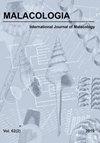阿根廷巴塔哥尼亚沙滩潮间带蛤的繁殖和补充(双壳亚目:圆蛤科)
IF 1
4区 生物学
Q4 ZOOLOGY
引用次数: 1
摘要
摘要(P. P. King, 1832)是南美洲南部沙滩上的一种丰富的蛤。它具有重要的生态作用,是包括候鸟在内的海洋捕食者的主要食物来源,也是寄生生命周期的中间宿主。我们描述了阿根廷巴塔哥尼亚中部与环境因素有关的D. solenoides的繁殖周期和招募。2年(2016-2017年)每月检测各性腺分期组织学分析及状态指数(CI)、卵母细胞密度、相对卵母细胞面积(ROA)等定量指标;n = 1,315),从圣乔治湾(SJG)的两个沙质海岸收集的蛤中采集。征聘模式是在一个地点进行的。壳长在25.2 ~ 42.8 mm之间,雌雄比在1:1以内无显著差异。被地沟虫完全或部分阉割的蛤蜊比例很低(< 5%)。发现了一个明确的年度生殖周期,其特点是性别、年份和地点之间高度同步。阴囊细胞的增殖持续到寒冷月份,卵黄形成主要发生在春季海水温度升高和主要浮游植物繁殖后不久。卵母细胞的最大发育期(平均直径32.1±12.9µm)和雄性和雌性的最大产卵期发生在南方夏季。夏季沉降量最高(平均= 162.8±47.1 indm -2),与第二次浮游植物繁殖相吻合,这可能有利于幼虫的发育和随后的早期招募。这是对西南大西洋双壳类的首次生殖研究,为巴塔哥尼亚沙滩上这一关键物种的种群动态提供了有用的信息。本文章由计算机程序翻译,如有差异,请以英文原文为准。
Reproduction and Recruitment of the Intertidal Clam Darina solenoides (Bivalvia: Mactridae) in Patagonian Sandy Shores, Argentina
ABSTRACT Darina solenoides (P. P. King, 1832) is an abundant clam of sandy shores of southern South America. It has an essential ecologic role as a main food source for marine predators, including migratory seabirds, and is an intermediate host in parasitic life cycles. We describe the reproductive cycle and recruitment of D. solenoides in relation to environmental factors in central Patagonia, Argentina. Histological analysis of gonadal stages and quantitative indicators such as the condition index (CI), oocyte density and relative oocyte area (ROA) were examined monthly for two years (2016–2017; n = 1,315) from clams collected from two sandy shores of the San Jorge Gulf (SJG). Recruitment pattern was followed at a single site. The shell lengths ranged between 25.2 and 42.8 mm and the sex ratio did not differ significantly from 1:1. The proportion of clams showing total or partial castration by digenean trematodes was low (< 5%). A clear annual reproductive cycle was found and was characterized by high synchrony between sexes, years and sites. Proliferation of gonia extended throughout the colder months and vitellogenesis occurred mainly during the spring increase of seawater temperature and shortly after the major phytoplankton bloom. Maximum development of oocytes (mean diameter, 32.1 ± 12.9 µm) and presumed spawning by both males and females occurred during the austral summer. Settlement was also highest (mean = 162.8 ± 47.1 ind.m-2) during summer and was coincident with a second phytoplankton bloom that might favour larval development and subsequent early recruitment. This is the first reproductive study of a mactrid bivalve from the southwest Atlantic Ocean and provides useful information on the population dynamics of this key species from Patagonian sandy shores.
求助全文
通过发布文献求助,成功后即可免费获取论文全文。
去求助
来源期刊

Malacologia
生物-动物学
CiteScore
2.00
自引率
0.00%
发文量
15
审稿时长
3 months
期刊介绍:
Malacologia publishes papers on all groups of the Mollusca. Malacologia specializes in publishing long papers and monographic treatments. Complete data are especially appreciated. Papers must be of interest to an international readership. Papers in systematics, ecology, population ecology, genetics, molecular genetics, evolution and phylogenetic treatments are especially welcomed. Also welcomed are letters to the editor involving papers published or issues of import to science of the day.
 求助内容:
求助内容: 应助结果提醒方式:
应助结果提醒方式:


